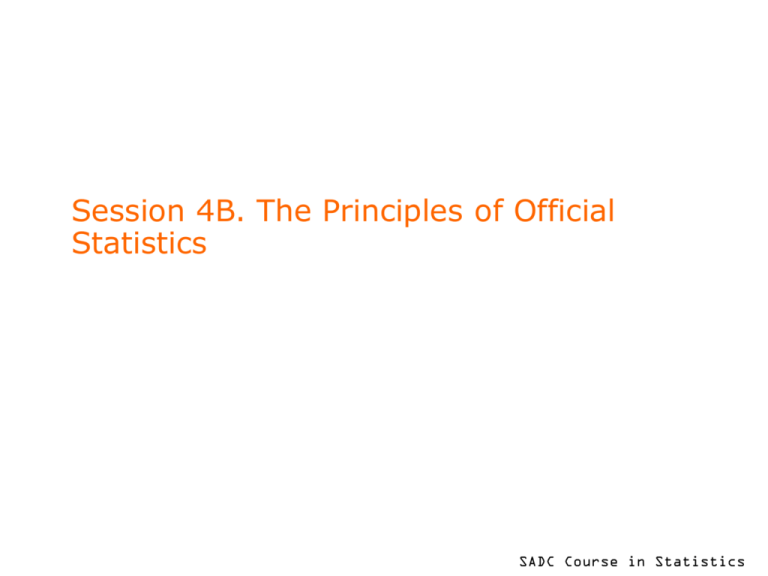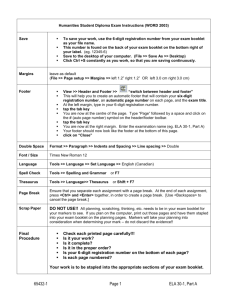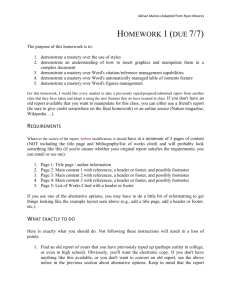Sesion 4B. The Principles of Official Statistics
advertisement

Session 4B. The Principles of Official Statistics SADC Course in Statistics Introduction • This is a follow up to Session 4a in which you were introduced to the National Statistical Office, its structure, what it produces, the Statistics Act, the concept of Official Statistics, their attributes and the role of Official Statistics. • This session will generally focus on the principles of Official Statistics. To put your footer here go to View > Header and Footer 2 Background to the development of the Principles • their development was necessitated by what was happening in Central Europe in the 1980s • it is during this time when most countries abandoned centralised economies and moved towards market economies. • It also during this period that the Soviet Union as a bloc collapsed and new nations were created. • These changes brought with them the need to completely transform National Statistical Systems in general and National Statistical Offices in particular, across the whole of Europe. To put your footer here go to View > Header and Footer 3 Background to the development of the Principles • This process entailed redefining the role of Official Statistics and enlightening governments and users of statistics that official statistics should meet a certain level of standard or criterion. • To achieve this, the Principles of Official Statistics were developed. • The United Nations endorsed these Principles in 1994 To put your footer here go to View > Header and Footer 4 The Principles of Official Statistics • National Statistical Offices should comply with these for the public to have trust in Official Statistics. • In general, they emphasise on the following: – Professional independence – Relevance – Credibility – Respondent relations To put your footer here go to View > Header and Footer 5 • Principle 1. Official statistics provide an indispensable element in the information system of a democratic society, serving the Government, the economy and the public with data about the economic, demographic, social and environmental situation. To this end, official statistics that meet the test of practical utility are to be compiled and made available on an impartial basis by official statistical agencies to honour citizens' entitlement to public information. To put your footer here go to View > Header and Footer 6 • Principle 2. To retain trust in official statistics, the statistical agencies need to decide according to strictly professional considerations, including scientific principles and professional ethics, on the methods and procedures for the collection, processing, storage and presentation of statistical data. To put your footer here go to View > Header and Footer 7 • Principle 3. To facilitate a correct interpretation of the data, the statistical agencies are to present information according to scientific standards on the sources, methods and procedures of the statistics • Principle 4. The statistical agencies are entitled to comment on erroneous interpretation and misuse of statistics. To put your footer here go to View > Header and Footer 8 • Principle 5. Data for statistical purposes may be drawn from all types of sources, be they statistical surveys or administrative records. Statistical agencies are to choose the source with regard to quality, timeliness, costs and the burden on respondents. • Principle 6. Individual data collected by statistical agencies for statistical compilation, whether they refer to natural or legal persons, are to be strictly confidential and used exclusively for statistical purposes. To put your footer here go to View > Header and Footer 9 • Principle 7. The laws, regulations and measures under which the statistical systems operate are to be made public • Principle 8. Coordination among statistical agencies within countries is essential to achieve consistency and efficiency in the statistical system. • Principle 9. The use by statistical agencies in each country of international concepts, classifications and methods promotes the consistency and efficiency of statistical systems at all official levels. • Principle 10. Bilateral and multilateral cooperation in statistics contributes to the improvement of systems of official statistics in all countries. To put your footer here go to View > Header and Footer 10 Implementation of the Principles • After the endorsement in 1994, member states of the UN have implemented the Principles of Official Statistics. • A survey by the UN was conducted to assess the levels of implementation among nations and below are some of the findings: – principle 6 – is the best implemented although cases of disclosure have been reported – principles 4 and 8 – are the least implemented. – as for the other Principles, implementation is at different levels To put your footer here go to View > Header and Footer 11 Challenges in implementing the Principles The survey noted that the following challenges have been encountered by member countries of the UN in implementing the Principles of Official statistics: • Authorised and unauthorised disclosure of individual data for non statistical purposes • Political interference at the data dissemination stage • The need to adapt international standards to national circumstances • Lack of resources To put your footer here go to View > Header and Footer 12 Resources • http://aprox.government.gov.sk/iap/regtrans.nsf/ 0/7ae65f015ad627f0c1256b7d00520921/$FILE/cp j,540,2001,35161,02.doc • http://www.dpsa.gov.za/documents/service_delive ry_review/vol1no3/how%20the%20national%20st atistics%20system%20impacts%20on%20service %20delivery.pdf • http://www.paris21.org/documents/whygovernments-need-good-statistics.pdf To put your footer here go to View > Header and Footer 13 Resources • http://www.nass.usda.gov/mexsai/Papers/strategi esp.doc • http://unstats.un.org/unsd/methods/statorg/FPEnglish.htm • http://www.paris21.org/pages/designingnsds/NSDS-documents-knowledgebase/index.asp?orderby=e&orderin=1&tab=Knowl edgeBase&option=doc • http://www.statssa.gov.za/about_statssa/strategic _plan.pdf To put your footer here go to View > Header and Footer 14 To put your footer here go to View > Header and Footer 15







